I
Introduction
Bill Gates is well known not just for his great wealth and contribution to the advancement of technology but also for his acts of philanthropy. The American billionaire stands out for his significant contribution to research and philanthropic initiatives especially during the coronavirus outbreak. Overall, Bill Gates has donated more than $50 billion to charity since 1994. Likewise, his fortune has expanded quicker than his donations.
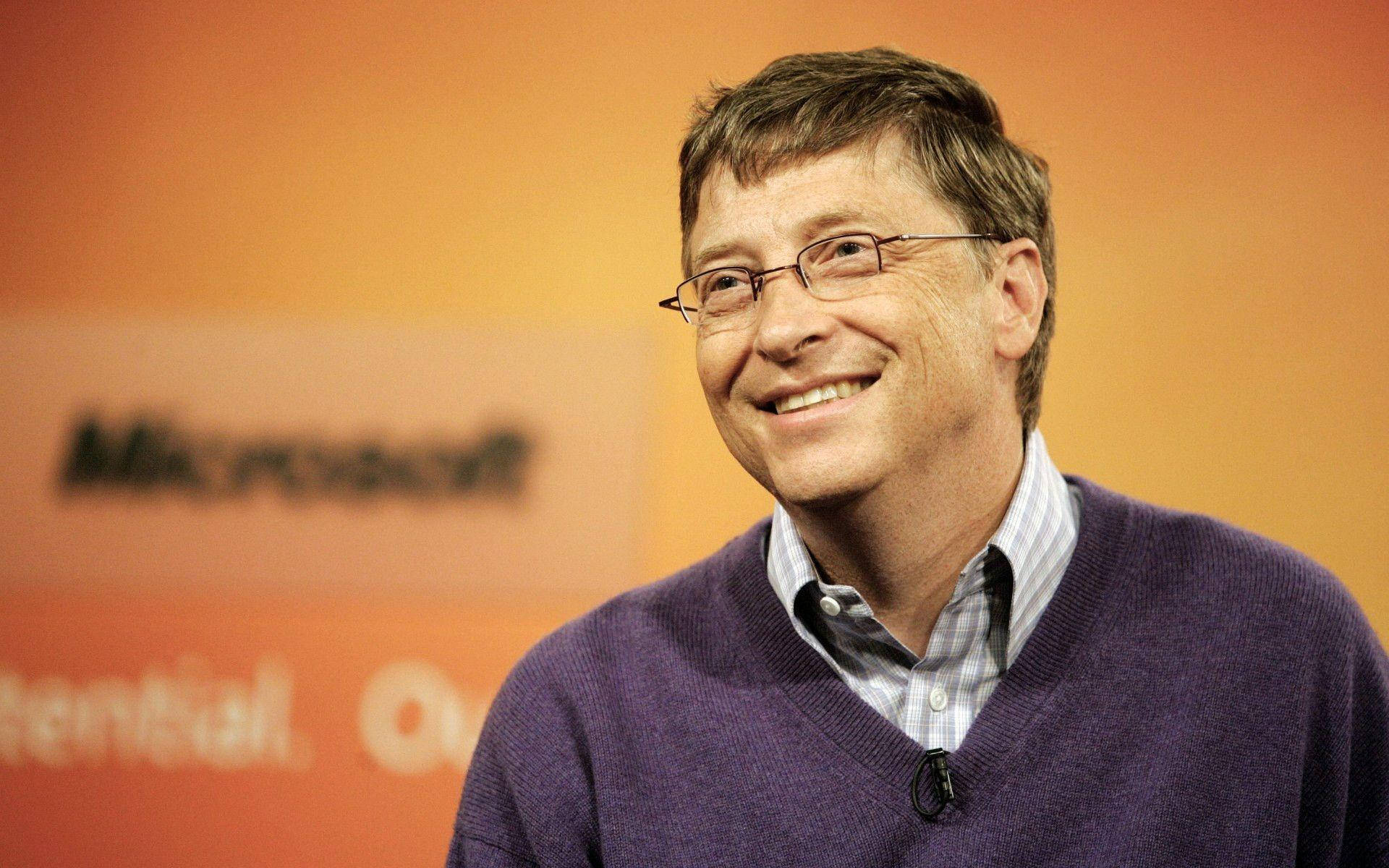
Despite the vast substantial gifts and pledges, Gates continues to maintain his position as one of the wealthiest people in the world. Bill Gates was the world’s richest man from 2000 until 2007. Currently, Gates is still the world’s sixth-richest person, according to Forbes.
II
Who is Bill Gates?
Bill Gates made his fortune as a co-founder of Microsoft. By and large, the company largely contributed to the personal computer revolution in the 1990s. Following Microsoft’s expansion to a corporate behemoth, Gates became a household name as a tech titan and commercial billionaire.
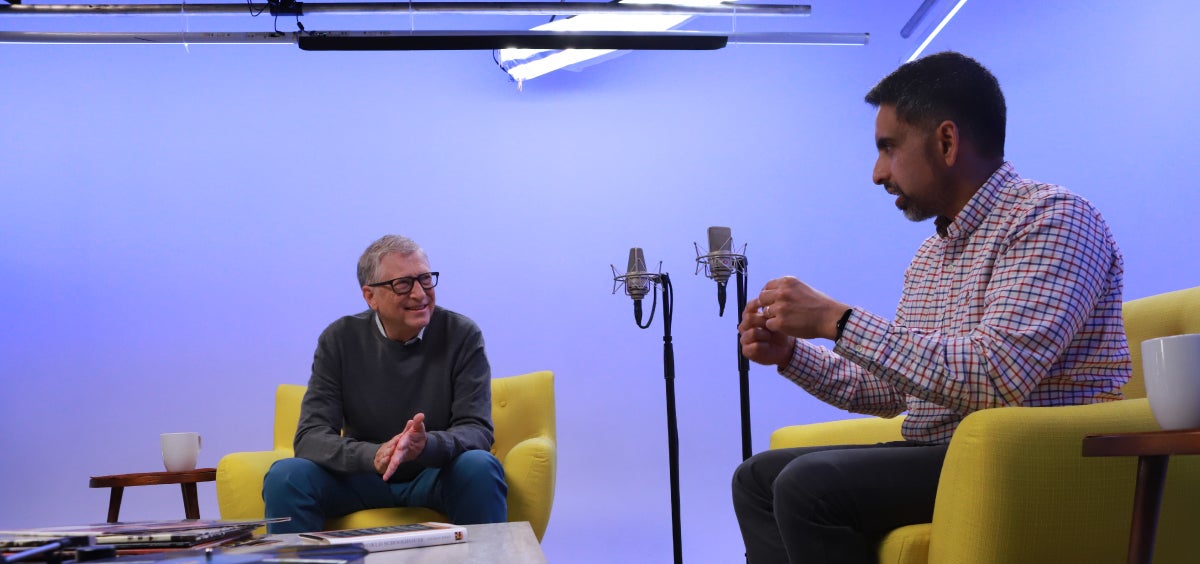
Gates, in January 2020, stepped down as CEO of Microsoft to focus on philanthropy as well as other side initiatives. Also, in March 2020, Gates resigned from Microsoft’s board of directors. However, he still owns roughly 1.3% of the company.
Gates, like many other high-net-worth individuals, manages his wealth through Cascade Investing LLC, an investing and holding firm. Through wealth management and investment in technology, Gates continues to preserve his riches and maintain his position as one of the world’s richest men.
III
History of the Bills and Melinda Gates Foundation
Bill Gates is known for his impact across various charity organizations over the years. However, his most notable charity effort is the establishment of the Bill and Melinda Gates Foundation (BMGF) in 2000. According to NCBI, the BMGF is the largest charitable foundation in the USA.
Bill and Melinda were inspired to establish the foundation after reading a newspaper piece about millions of children dying of preventable diseases in underdeveloped nations.
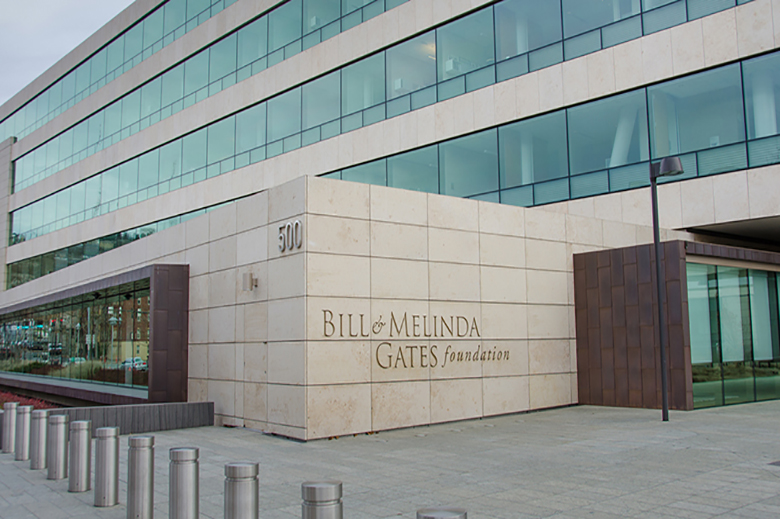
Essentially, the foundation seeks to address some of the most pressing issues globally by adopting an entirely novel approach. Through its massive fund reserves, the foundation prioritizes global issues in contrast to regional issues. Also, to effect global change, BMGF collaborates with partners to expand its solutions to the local level.
Through the foundation, Bill Gates has provided over $59 billion in donations. In addition, the billionaire, through its “giving pledge” has secured the promise of over $365 billion in the foundation’s future.
The foundation began with the primary goal of addressing the treatment and prevention of Malaria and HIV across third-world nations. Afterward, BMGF shifted from merely supplying medical supplies to diversifying into various sectors of nonprofits such as education, women’s empowerment, and climate change among others. Also, Bill and Melinda constituted a significant contributor to a vaccine program that impacted vaccination rates across the globe.
According to the foundation’s website, their approach to grant-making is quite basic. Primarily, grants are given to promote collaboration, innovation, risk-taking, and, most importantly, outcomes in BMGF’s specific areas of focus.
IV
The Various Strategies of Bill and Melinda Gates Foundation
By and large, the foundation prioritizes specific areas of focus. In this section, we will consider some of the core focuses of the Bill and Melinda Gates Foundation.
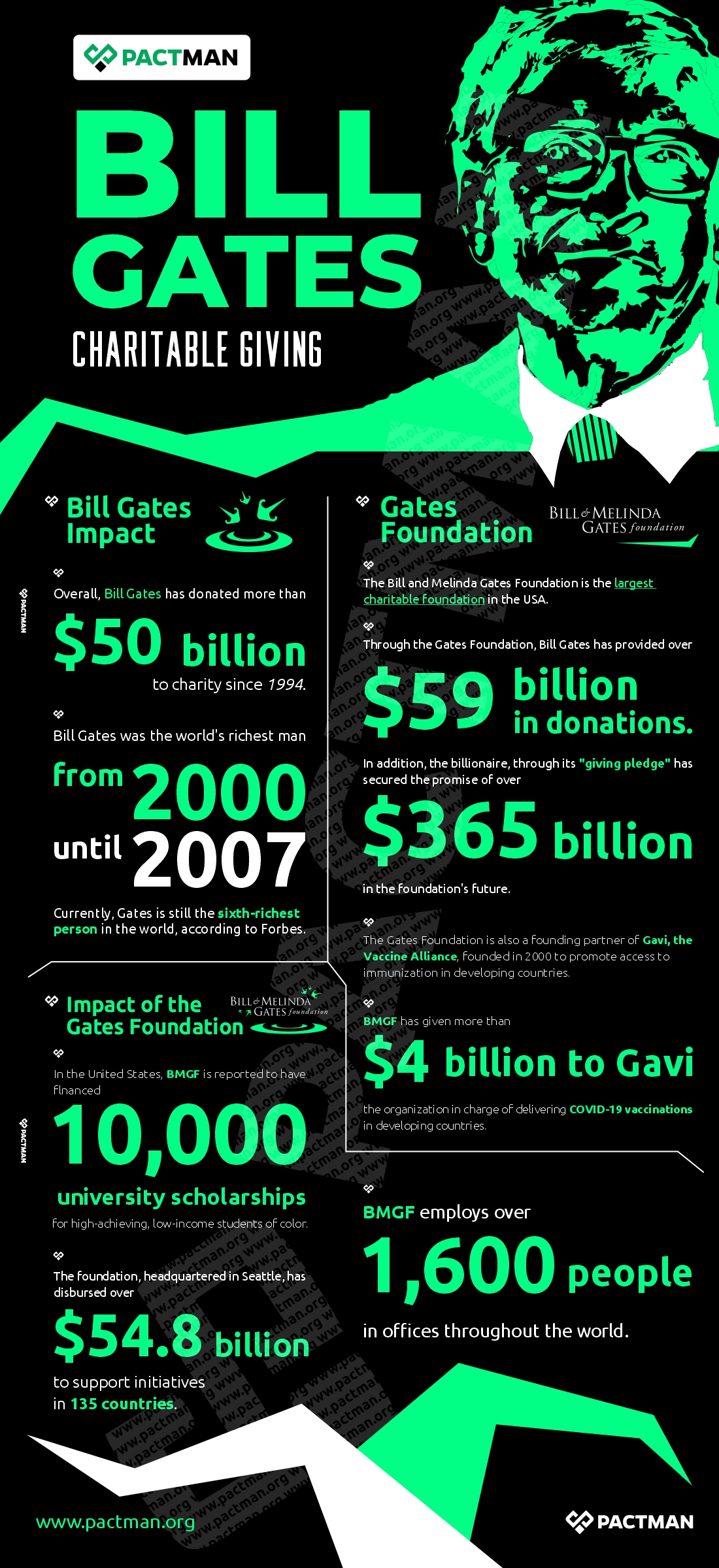
1. Global Health
Bill Gates is known for his consistent effort to eradicate malaria which was primarily the focal point for the foundation’s establishment. For the most part, diverse organizations and research groups work together and are controlled by the branch of the BMGF. Essentially, the Global Health Division leverages science and technology to improve and save lives in underdeveloped countries.
In addition, the foundation helps to facilitate access to tried-and-true healthcare technologies. BMGF sponsors research into game-changing innovations while providing access to health interventions for the people and places who need them the most.
Overall, the global health division focuses on a variety of issues, including diarrheal diseases, HIV, Malaria, pneumonia, TB, neglected tropical diseases, vaccine development, maternity and child health, epidemiology, and research and discovery sciences.
The Gates Foundation is also a founding partner of Gavi, the Vaccine Alliance, founded in 2000 to promote access to immunization in developing countries. BMGF has given more than $4 billion to Gavi, the organization in charge of delivering COVID-19 vaccinations in developing countries.
2. Global Development
The Global Development division prioritizes issues that disproportionately affect people and regions in developing countries. BMGF seeks to address the huge disparities in capital and opportunities across various countries of the world. By and large, the disparity gap constitutes one of the most significant issues hindering the progress and development of various regions.
To begin with, the Global Development Division works to identify and fund high-impact solutions that can reduce health disparities and provide everyone with the opportunity to live healthy, productive lives. Hence, BMGF adopts and supports innovative approaches while expanding existing ones to reach the most vulnerable people.
Overall, the division seeks to address issues such as emergency response development, family planning, global libraries, integrated health services delivery, nutrition, polio, maternity and child health, and vaccine distribution.
3. Global Growth & Opportunity
Statistics show that over 1.9 billion people globally live on less than $3.20 per day. In addition, more than 1 billion people are reported to suffer from chronic hunger. Addressing this global plague will demand more than just making funds available.
Primarily, the BMFG tackles the issues of poverty by adopting a straightforward approach. According to Bill Gates, the major reason why people are poor is because markets do not work for them. Hence, to combat this issue, BMGF promotes innovative products and policies that can break down barriers to economic opportunity and assist people in lifting themselves out of poverty. Likewise, the foundation works to deliver sustainable and inclusive growth that benefits various regions globally.
Over the years, BMGF has invested in data and measurement to understand and address the underlying causes of poverty. By and large, the goal is to develop evidence-based and scalable solutions.
Likewise, the division is primarily concerned with agricultural development to combat world hunger. Other critical areas of the division include providing financial services and business loans for the poor, gender equality, and enhancing water, sanitation, and hygiene.
4. Global Policy & Advocacy
The Global Policy and Advocacy Division works to promote public policies that advance their work, forges strategic alliances with governments, and the public and private sectors, and raises public awareness of pressing global issues.
This division is responsible for assembling teams dedicated to lobbying, policy analysis, media and communications, government relations, and developing the charitable sector and philanthropic relationships in the United States and abroad.
In addition, the division collaborates closely with offices in the United States, Europe, China, India, Ethiopia, Nigeria, and South Africa to embrace a worldwide approach. The key issues that the division seeks to address include tobacco control, development policy, and financing, and the establishment of a global education learning plan.
5. United States
BMGF also works to ensure that students are provided the opportunity to graduate from high school, prepare for college, and pursue a postsecondary degree with labor-market value. The foundation’s strategy is to act as a catalyst to assist in the development of creative education solutions that are yet to be developed by institutions working alone. By and large, the goal is to spark change on a larger scale.
This division prioritizes K-12 education, economic mobility and opportunity, and postsecondary success and access. In addition, the foundation seeks to combat social unfairness and poverty in Washington State, where the Gates family has lived for many years and where the foundation is based.
In the United States, BMGF is reported to have financed 10,000 university scholarships for high-achieving, low-income students of color.
6. Gender Equality
The Gender Equality Division empowers women and girls, particularly in Africa and South Asia through various funding programs, campaigns, and projects. Primarily, women are allowed to lead within their society, make their own decisions, enjoy good health, and earn an income.
The goal of the division is to hasten the process of achieving gender parity. BMGF seeks to identify and remove obstacles that keep women and girls from reaching their goals. By and large, the foundation prioritizes initiatives for women and girls in low- and middle-income countries in sub-Saharan Africa and South Asia. BMGF works together with its partners to ensure effectiveness while accelerating the gains already made. Likewise, the foundation emphasizes and assists regions with the most need.
Another significant emphasis of the foundation is improving sanitation.
The foundation, headquartered in Seattle, has disbursed over $54.8 billion to support initiatives in 135 countries. Also, BMGF employs over 1,600 people in offices throughout the world.
The Gates Foundation is the world’s largest organization of its kind, with an endowment of over $50 billion (£36 billion), surpassing the GDP of most countries. A significant supporter of the foundation is Warren Buffett who contributed over $30 billion to the organization in 2006.
In 2010, Bill and Melinda Gates in alliance with Warren Buffett established the Giving Pledge campaign. The goal of the campaign is to encourage other wealthy people to contribute a large portion of their finances to charitable organizations.
The foundation’s annual donation in 2018 made it the second-largest private donor to the World Health Organization (WHO), after only the United States.
V
Bill Gates Most Notable Contributions to Charity Organizations and Public Institutions
The act of philanthropy is quite rampant among the super-rich in the US. Primarily, they enable tax avoidance provided five percent of net investment assets are given away annually. However, Bill Gates stands out for his orientation towards eradicating poverty and influencing global policies to enhance better living.
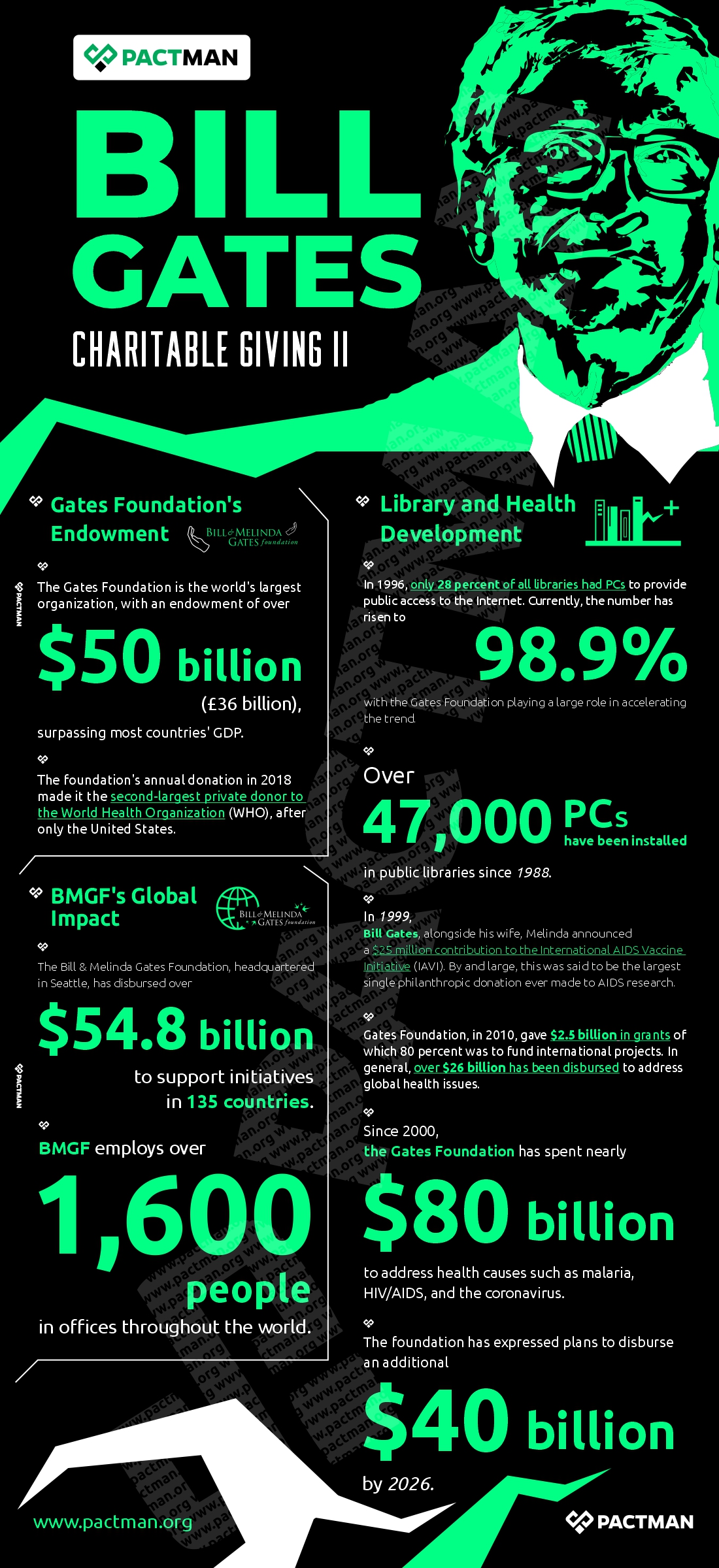
In this section, we will consider some of the most significant charitable contributions made by Bill Gates.
1. Library Development
In 1996, only 28 percent of all libraries had PCs to provide public access to the Internet. Currently, the number has risen to 98.9% with the Gates Foundation playing a large role in accelerating the trend. Over 47,000 PCs have been installed in public libraries since 1988. This has largely aided communities where at least 10 percent of the population lives below the federal poverty level.
But beyond hardware, Bill Gates, through his foundation, has empowered libraries in leadership skills and training. The billionaire also contributed to the development of a simplified approach to the use and maintenance of PCs.
2. Health Development
Also, in 1999, Bill Gates, alongside his wife, Melinda announced a $25 million contribution to the International AIDS Vaccine Initiative (IAVI). By and large, this was said to be the largest single philanthropic donation ever made to AIDS research.
Trevor Neilson, a spokesperson for the foundation reported that $13.5 million was to fund three new international AIDS vaccine development teams. In addition, $3.5 million was to support the two teams that worked on developing HIV vaccines specifically for Kenya and South Africa. Lastly, between $2.5 million and $3.5 million was given to support IAVI’s applied research program, advocacy, and clinical trial preparation in developing countries as well as their operational support.
Gates Foundation, in 2010, gave $2.5 billion in grants of which 80 percent was to fund international projects. In general, over $26 billion has been disbursed to address global health issues.
Since 2000, the Gates Foundation has spent nearly $80 billion to address health causes such as malaria, HIV/AIDS, and the coronavirus. By and large, annual spending has risen to about $1 billion. Even more, the foundation has expressed plans to disburse an additional $40 billion by 2026.
Bill Gates Foundation is the main player in several global health partnerships. Not to mention, the foundation constitutes one of the single largest donors to the WHO. Only the United States and the United Kingdom currently provide large contributions to global health. Bill Gates, in 2021, donated $15 billion which was 783 percent more than the second-largest donor in the U.S.
This gives the Gates Foundation considerable leverage in shaping health policies across the globe.
3. Nonprofit Resource Development
In 2009, the Foundation supported the development of the Statewide Nonprofit Resource Directory, the 501 Commons website.
Also, in 2010, Bill and Melinda Gates, alongside billionaire investor Warren Buffett, founded the “Giving Pledge,” a movement encouraging other billionaires to donate most of their wealth to charity. Currently, the voluntary group comprises over 200 families and individuals from more than 20 countries.
In 2019, Bill and Melinda donated $589 million to charity, making them the seventh most philanthropic people.
Bill Gates evolved a corporate culture at Microsoft that has resulted in a thriving nonprofit sector. Microsoft workers continue to play a crucial role in impacting the nonprofit sector. Social Venture Partners was established in the 1990s and 80% of the organization comprises current or former Microsoft workers. For the most part, the group incorporates financial and volunteer-time contributions into each member’s commitment. Overall, the group has branches in more than 40 cities around the world.
Gates’ philanthropy aims not only to make businesses more philanthropic but also to make charity more business-like. The strategy, known as ‘philanthrocapitalism’ or ‘venture philanthropy,’ is based on NGOs vying for donations and having their success evaluated using business measures.
4. Vaccine Development
GAVI Alliance, a public-private organization founded by Bill Gates has significantly contributed to the development of new vaccines. Likewise, the corporation, with an initial grant of $750 million seeks to increase access to immunization by providing vaccines for Hepatitis B and the HiB bacteria.
GAVI is also working on developing new vaccines for pneumococcus and rotavirus which causes pneumonia and diarrhoea.
Through GAVI, the foundation has played a huge role in lowering the costs of Hepatitis B inoculations. In addition, the corporation has also provided $1.5 billion in support to ‘advanced market commitment’ to develop pneumococcal vaccines.
5. Family Planning
The Gates Foundation, in alliance with a group called PATH, has developed various initiatives to promote family planning. Gates has been a major contributor to the group which is one of the world’s biggest nonprofit developers of vaccines, medical devices, and treatments. PATH began in Seattle in the mid-1970s and has over 450 employees.
6. Institutional Development
Bill Gates has always been at the forefront of addressing global health and improving US education. The billionaire largely provides funds to institutions ranging from US university departments to major international development NGOs.
‘Our net effect should be to save years of life for well under $100; so, if we waste even $500,000, we are wasting 5,000 years of life,’ Gates once stated. The best results, according to the billionaire, are obtained through vertically funded projects such as interventions that target specific diseases or health problems.
From 2014 to 2019, the Gates Foundation generated approximately $28.5 billion in investment revenue. Over the same period, it disbursed $23.5 billion in grants, which constitute a net profit. The Microsoft co-founder, in 2022, gave $5 billion to the Bill & Melinda Gates Foundation to help support its work in global health, development, policy and advocacy, and U.S. education.
Although the billionaire has given over $50 billion since the founding of his foundation, Gates’ fortune has increased from $39 billion in 1997 to about $111.2 billion today. Up until now, Bill Gates remains unrivaled in the realm of humanitarian giving.
Conclusion
To sum up, Bill Gates stands out as a consistent philanthropist maintaining his passion for decades. Every steady increase in his financial portfolio always follows the disbursement of a significant amount of his net worth. Likewise, the Bill & Melinda Gates Foundation is renowned for its contributions to the nonprofit sector. Every year, the foundation spends billions of dollars to support initiatives that seek to eradicate diseases and combat poverty. By and large, the billionaire’s impact on the charitable sector is substantial and vast, and yet there is more to come as Bill Gates continues to reveal plans for future investment.



One Response